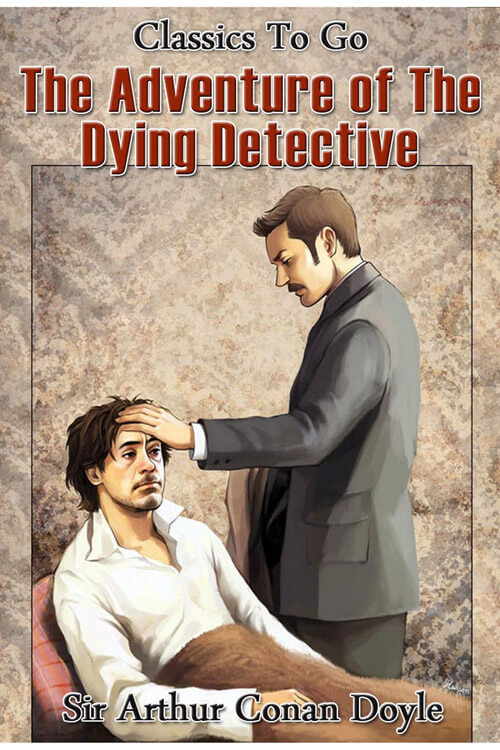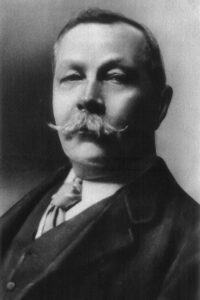
The Adventure of the Dying Detective
“The first three sensible words you have uttered since entering this room, Watson. You will find some books over there. I am somewhat exhausted; I wonder how a battery feels when it pours electricity into a non-conductor. At six, Watson, we resume our conversation.”
But it was destined to be resumed long before that hour, and in circumstances that gave me a shock hardly second to that caused by his spring to the door, I had stood for some minutes looking at the silent figure in the bed. The clothes almost covered his face, and he appeared asleep. Then, unable to settle down to reading, I strolled around the room, examining the pictures of celebrated criminals with which every wall was adorned. Finally, in my aimless perambulation, I came to the mantelpiece. A litter of pipes, tobacco pouches, syringes, penknives, revolver cartridges, and other debris was scattered over it. Amidst these was a small black and white ivory box with a sliding lid. It was a neat little thing, and I had stretched out my hand to examine it more closely when
He gave a dreadful cry—a yell which might have been heard down the street. My skin went cold, and my hair bristled at that horrible scream. As I turned, I caught a glimpse of a convulsed face and frantic eyes. I stood paralyzed, with the little box in my hand.
“Put it down! Down, this instant, Watson—this instant, I say!” His head sank back upon the pillow, and he gave a deep sigh of relief as I replaced the box on the mantelpiece. “I hate to have my things touched, Watson. You know that I wouldn’t say I like it. You fidget me beyond endurance. You, a doctor—you are enough to drive a patient into an asylum. Sit down, man, and let me have my rest!”
The incident left a most unpleasant impression on my mind. The violent and causeless excitement, followed by this brutality of speech so far removed from his usual suavity, showed me how deep his mind was disorganized. Of all ruins, that of a noble mind is the most deplorable. I sat in silent dejection until the stipulated time had passed. He seemed to have been watching the clock as well as I, for it was hardly six before he began talking with the same feverish animation.
“Now, Watson,” said he. “Have you any change in your pocket?”
Read or download Book
Arthur Conan Doyle
Sir Arthur Ignatius Conan Doyle KStJ, DL (22 May 1859 – 7 July 1930) was a British writer and physician. He created the character Sherlock Holmes in 1887 for A Study in Scarlet, the first of four novels and fifty-six short stories about Holmes and Dr. Watson. The Sherlock Holmes stories are milestones in the field of crime fiction.
Doyle was a prolific writer. In addition to Holmes’s stories, his works include fantasy and science fiction stories about Professor Challenger and humorous stories about the Napoleonic soldier Brigadier Gerard, as well as plays, romances, poetry, nonfiction, and historical novels. One of Doyle’s early short stories, “J. Habakuk Jephson’s Statement” (1884), helped popularise the mystery of Mary Celeste.
Literary career
Doyle struggled to find a publisher. His first work featuring Sherlock Holmes and Dr Watson, A Study in Scarlet, was written in three weeks when he was 27 and was accepted for publication by Ward Lock & Co on 20 November 1886, which gave Doyle £25 (equivalent to £2,900 in 2019) in exchange for all rights to the story. The piece appeared a year later in the Beeton’s Christmas Annual and received good reviews in The Scotsman and the Glasgow Herald.
Holmes was partially modelled on Doyle’s former university teacher, Joseph Bell. In 1892, in a letter to Bell, Doyle wrote, “It is most certainly to you that I owe Sherlock Holmes … round the centre of deduction and inference and observation which I have heard you inculcate I have tried to build up a man”, and in his 1924 autobiography, he remarked, “It is no wonder that after the study of such a character I used and amplified his methods when in later life I tried to build up a scientific detective who solved cases on his own merits and not through the folly of the criminal.” Robert Louis Stevenson recognised the substantial similarity between Joseph Bell and Sherlock Holmes: “My compliments on your very ingenious and exciting adventures of Sherlock Holmes. … can this be my old friend Joe Bell?” Other authors sometimes suggest additional influences, such as Edgar Allan Poe’s character, C. Auguste Dupin, who is mentioned disparagingly by Holmes in A Study in Scarlet. Dr. (John) Watson owes his surname to a Portsmouth medical colleague of Doyle’s, Dr. James Watson, but not any other prominent characteristic.
A sequel to A Study in Scarlet was commissioned, and The Sign of the Four appeared in Lippincott’s Magazine in February 1890, under agreement with the Ward Lock company. Doyle felt grievously exploited by Ward Lock as an author new to the publishing world, and so, after this, he left them. Short stories featuring Sherlock Holmes were published in the Strand Magazine. Doyle wrote the first five Holmes short stories from his office at 2 Upper Wimpole Street (then Devonshire Place), now marked by a memorial plaque.
Doyle’s attitude towards his most famous creation was ambivalent. In November 1891, he wrote to his mother: “I think of slaying Holmes… and winding him up for good and all. He takes my mind from better things.” His mother responded, “You won’t! You can’t! You mustn’t!” In an attempt to deflect publishers’ demands for more Holmes stories, he raised his price to a level intended to discourage them but found they were willing to pay even the large sums he asked. As a result, he became one of the best-paid authors of his time.






